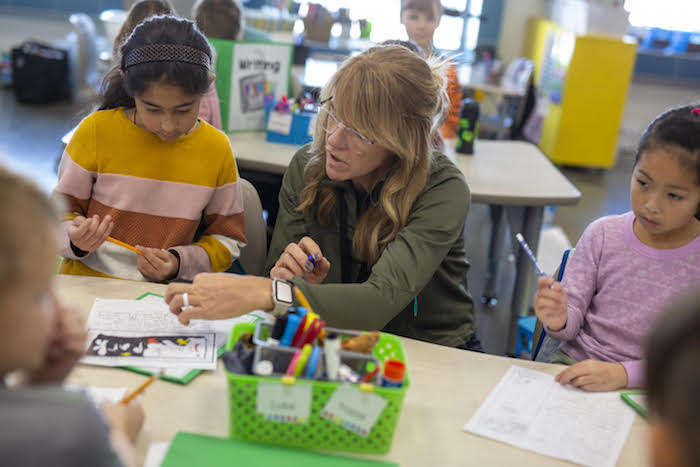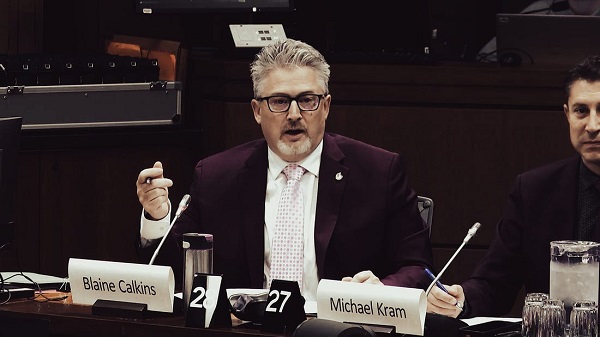Education
Red Deer Public sets its strategic direction for the next three years

Red Deer Public Schools has set its strategic direction after the Board of Trustees approved the Three Year Education Plan.
“The highest priority for our Division is the success of every student. Our focus is to ensure there is excellence in teaching and learning in every classroom across Red Deer Public Schools,” said Board Chair Nicole Buchanan. “To ensure every student reaches their full potential, our three priority areas include Literacy and Numeracy, Equity and Student Success and Completion.”
Seven proposed outcomes ensuring that all students reach their full potential will be supported by nine specific strategies. Some of these strategies include implementing and professionally staffing Student Support Rooms in schools to provide additional supportive options for students experiencing issues such as dysregulation and anxiety; implementing a comprehensive bullying intervention plan, which includes initiatives involving the prevention of bullying; the intervention process when bullying occurs; and the collaboration between parents/guardians, staff and students. The plan, which will be evaluated on an ongoing basis, will help Red Deer Public strive to continually improve its approach to addressing bullying in the schools.
“During our Community Engagement earlier this year, we heard from students at various grade levels that bullying is an issue in schools,” said Buchanan. “In response to hearing this, we will take a look at how we can prevent and provide further education about bullying. As we move forward in the upcoming school year, this initiative will involve students, staff and parents in terms of developing strategies of what this will look like.”
Work on the bullying intervention plan will begin in the 2023/2024 school year.
The implementation of Student Support Rooms in most elementary, K – 8 and middle schools for the 2023/2024 school year is also part of the Division’s Three Year Plan.
“These Student Support Rooms will be overseen by a full-time certified teacher, and will meet the needs of hundreds of students across the Division,” said Buchanan. “All students, no matter their age, grade or ability are supported in the Division, not just academically but emotionally, mentally and physically. The Student Support Rooms will be in addition to the various wrap around support services for students.”
In addition, Red Deer Public will research and explore various models to more equitably redistribute educational funding to schools, with implementation to occur during the 2024/2025 school year.
“We have schools with varying needs in our Division, so our goal is to explore a different model in which educational funds may be distributed more equitably depending on each individual schools’ needs,” said Buchanan.
The Three Year Education Plan was approved by the Board of Trustees on May 10.
Alberta
Province orders School Boards to gather data on class sizes and complexity by Nov 24

Better data, better outcomes for Alberta students |
To help schools address classroom complexity, Alberta’s government will begin collecting annual data on class size and composition.
Over the past three years, Alberta has welcomed more than 80,000 new students. With this unprecedented growth, classroom complexity and class sizes are among the biggest issues facing schools and teachers across the province.
To meet this challenge head on, Alberta’s government will work with school boards to gather yearly data on class sizes and composition. This information will be used to better understand staffing, student needs and classroom complexity. School boards will be required to submit data on Alberta classrooms by Nov. 24, and by January, this data will be made publicly available and will then be released annually.
Data collected on classroom complexity will help the province understand and address issues in schools, including class sizes, and support strategic investments in classrooms. Over the next three years, school boards will be provided with funding to hire 3,000 teachers and 1,500 new education assistants to support students with complex needs.
“We are ready to work with school boards and teachers to address classroom complexity and class sizes. We have heard them loud and clear and we are taking bold action to address these issues.”
Alberta’s government is establishing a Class Size and Complexity Task Force to begin work immediately on identifying solutions to the challenges facing Alberta classrooms. Alongside new annual data collection, the task force will ensure every student gets the attention and support they need to succeed. Details about the task force will be shared in the coming weeks.
“This data will provide essential insight into classroom realities, guiding evidence-based decisions and advocating for sustainable funding to address complexity, ensuring every student and educator in Alberta has the support to thrive.”
Quick facts
To inform decisions on addressing classroom complexity, data will be collected on total numbers of:
- all staff, per school, including roles
- substitute teachers
- district staff, listed by job title
- students, per classroom, per school
- severe, mild/moderate, and gifted/talented students, per classroom, per school
- English as an additional language (EAL) students, per classroom, per school
- refugee students, per classroom, per school
- First Nations, Métis and Inuit students, per classroom, per school
- Individualized Program Plans, per classroom, per school
- students waitlisted for assessment, per classroom, per school
- incidents of aggression and violence
- $55 million was provided in Budget 2025 to address classroom complexity.
- 8.6 billion is being invested to build and renovate more than 130 schools across the province.
- Budget 2025 is investing $1.6 billion in learning support funding to help meet students’ specialized learning needs.
- Budget 2025 is investing $1.1 billion to hire more than 4,000 teachers and educational staff.
Alberta
How one major media torqued its coverage – in the take no prisoners words of a former Alberta premier

(Editor’s note: I was going to write on the media’s handling of the Alberta government’s decision to order striking teachers back to work and invoke Section 33 of the Charter in doing so. But former Alberta premier Jason Kenney provided such a fulsome dissection of an absence of balance and its consequences in terms of public trust on X that I asked him if The Rewrite could publish it. He said yes and here it is – Peter Menzies.)
By Jason Kenney
This ”story” is an object lesson for why trust in legacy media has plummeted, and alt right media audiences have grown.
”story” is an object lesson for why trust in legacy media has plummeted, and alt right media audiences have grown.
Here CTV “digital news producer” @AngeMAmato (she/her) writes a story about “experts” calling the use of Sec. 33 “a threat to democracy.”
Who are the experts?
A left wing academic, and a left wing activist. The latter, Howard Sapers, is a former Liberal MLA (which the article does not mention) for a party that is so marginal, it has not elected an MLA in over a decade.
For good measure CTV goes on to quote two left wing union bosses, who of course are predictably outraged.
A more accurate headline would be “Four people on the left angry about use of Notwithstanding Clause.” Which is the opposite of news. It’s the ultimate “Dog Bites Man” non-story.
Did the CTV producer make any effort to post a balanced story by asking for comment from academics / lawyers / think tanks who support use of Sec. 33? Did she call the @CDNConstFound or the @MLInstitute’s Judicial Power Project? Did she attempt to reach any of these four scholars, who just published their views in a @nationalpost op-ed last week?
Did she have an editor who asked why her story lacked any attempt at balance?
And did anyone at CTV pause for a moment to ponder how tendentious it is to accuse a democratically elected legislature of acting “undemocratically” by invoking a power whose entire purpose is to ensure democratic accountability?
She provides some historical context about prior use of Sec. 33. Why does that context not include the fact that most democratically elected provincial governments (including Alberta under Premier Lougheed, and Saskatchewan under NDP Premier Blakeney) agreed to adopt the Charter *only if* it included the Notwithstanding Clause to allow democratically elected Legislatures to ensure a democratic check and balance against the abuse of undemocratic, unaccountable judicial power?
Why does she not mention that for the first 33 years of the Charter era, the Canadian Courts ruled that there was no constitutionally protected right to strike?
Why doesn’t she quote an expert pointing out that Allan Blakeney defended the Saskatchewan Legislature’s 1986 use of Sec. 33 to end a strike as “a legitimate use of the Clause?” Or refer to Peter Lougheed’s 1987 commitment to use Sec. 33 if the courts invented a right to strike?
Many thoughtful criticisms can be levelled against Section 33. Being undemocratic is not one of them.
So why do we see so much agitprop like this masquerading as news from so many legacy media outlets?
IMO, there are two possible answers:
1) They are blind to their own biases; and / or
2) People like @AngeMAmato believe that they have a moral imperative to be “progressive journalists” which trumps the boringly old fashioned professional imperative to be objective and balanced.
Whatever the reason, “journalists” like this have no one to blame but themselves for growing distrust of legacy media, and the consequent emergence of non traditional media platforms.
 |
|
Invite your friends and earn rewards
-

 Alberta8 hours ago
Alberta8 hours agoFrom Underdog to Top Broodmare
-

 Media1 day ago
Media1 day agoCarney speech highlights how easily newsrooms are played by politicians
-

 Business1 day ago
Business1 day agoThe painful return of food inflation exposes Canada’s trade failures
-

 Business10 hours ago
Business10 hours agoPaying for Trudeau’s EV Gamble: Ottawa Bought Jobs That Disappeared
-

 Business13 hours ago
Business13 hours agoCBC uses tax dollars to hire more bureaucrats, fewer journalists
-

 National11 hours ago
National11 hours agoElection Officials Warn MPs: Canada’s Ballot System Is Being Exploited
-

 Economy5 hours ago
Economy5 hours agoIn his own words: Stunning Climate Change pivot from Bill Gates. Poverty and disease should be top concern.
-

 Addictions7 hours ago
Addictions7 hours agoThe Shaky Science Behind Harm Reduction and Pediatric Gender Medicine




